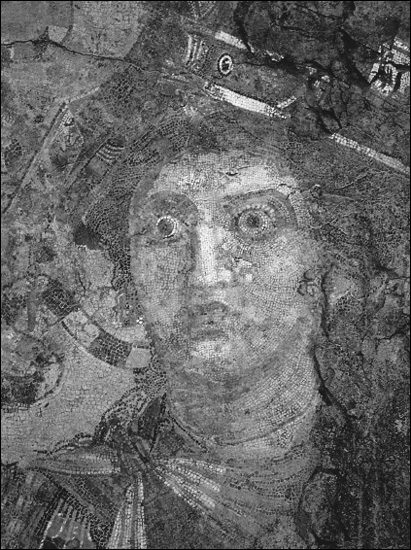Cleopatra (14 page)
Authors: Joyce Tyldesley

8. ‘Cleopatra restored’; two very different statues have been joined together to make one queen.




12. Romans relaxing on the Nile: fragment of mosaic recovered from Palestrina, Italy.



The Ptolemies valued the Museion as an obvious and internationally acknowledged manifestation of their city’s superiority. But it would be a mistake to imagine ancient Alexandria as a dull city dedicated to dry scholarship and reading. It was first and foremost a port, and the harbours and the marketplaces were hives of activity as Egypt’s own products (wheat, papyrus, linen, stone, glass, perfumes, drugs and spices) were joined with exotic goods from Africa, Asia and India, to be loaded on to large merchant ships and relatively small state-, temple- and privately-owned sailing boats. Away from the ports the streets teamed with a vibrant cross-section of life: itinerant traders and their customers, sailors, tourists, fortune seekers, soothsayers, musicians, thieves, prostitutes and many, many more. There were large glass, papyrus and linen factories, whose workers were formed into tradesmen’s guilds, and smaller workshops owned by potters, carpenters, weavers, bakers and undertakers.
The concept of
tryphe
– boundless, ostentatious luxury as a manifestation of power – underpinned the Alexandrian court. Years of dedicated eating and drinking had rendered Ptolemies VIII, IX and X spectacularly obese. Proud of his appearance, and of the luxurious over-consumption that it represented, Ptolemy VIII ‘Potbelly’ celebrated his excesses, and scandalised Roman visitors, by dressing in the filmiest of robes that left nothing to the imagination. It cannot have been a pleasant sight, as ‘his body had become corrupted by fat and a belly of such size that it would have been hard to measure it with one’s arms’.
13
The
symposium
, or male after-dinner drinking club, was a flourishing Greek bonding ritual. Groups of wealthy men reclined on couches to drink wine, tell riddles, play childish games (a very popular
game included flicking wine from a cup) and listen to music performed by slaves and prostitutes. Although the wine was mixed with water, the evening was quite likely to disintegrate into what today we might classify as an orgy of drinking. This did not matter overmuch. Immoderate drinking might be considered a tribute to Dionysos. It might even be beneficial to the system. Athenaeus, citing the respected Athenian physician Mnesitheus, advises us that:
It happens that those who drink a great quantity of unmixed wine at banquets often receive great injury from so doing, both in their bodies and minds; but still occasional hard drinking for some days appears to me to produce a certain purging of the body and a certain relaxation of the mind … Of all methods of purging, that which is caused by hard drinking is the most advantageous, for then the body is, as it were, washed out by the wine … But when you are drinking hard you should guard against three things – against drinking bad wine, against drinking unmixed wine, and against eating sweetmeats when you are drinking. And when you have had enough do not go to sleep until you have had a vomit, moderate or copious as the case may be, and when you have vomited, then go to sleep after you have taken a slight bath.
14
Excessive drinking naturally led to a great deal of casual sex: sex with fellow drinkers, sex with high-class prostitutes (
hetairai
), sex with flute girls and boys, sex with anyone, it seems, apart from wives. The Ptolemaic court allowed its men a great deal of sexual licence and even Ptolemy II, a twice-married man so devoted to his second wife that he deified her, was an inveterate womaniser:
The second king of Egypt, Ptolemy Philadelphos by name … had a great many mistresses – namely Didyma, who was a native of the country and very beautiful; and Bilistiche; and beside them,
Agathoclea; and Stratonice, who had a great monument on the seashore near Eleusis; and Myrtium; and a great many more; he was a man excessively addicted to amatory pleasures. And Polybius, in the fourteenth book of his History, says that there are a great many statues of a woman named Clino, who was his cupbearer, in Alexandria, clothed in a tunic only, and holding a cornucopia in her hand.
15
The Romans, who (in theory at least) dined with their wives rather than their lovers, found this shocking. The air of dissoluteness was compounded for them by the presence of eunuchs, invariably exslaves, in positions of high authority at the Ptolemaic court. The Ptolemies respected their eunuchs as exceptionally loyal servants capable of running both the royal household (with no danger of an unsuitable alliance with a royal princess) and, by extension, the country. But Roman law forbade castration, even the castration of a slave, and the Romans would come to regard the Alexandrian eunuchs as typifying the emasculating strength of Egypt’s women.